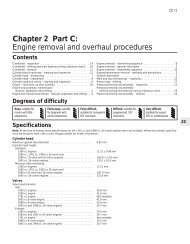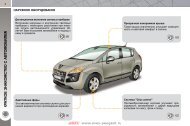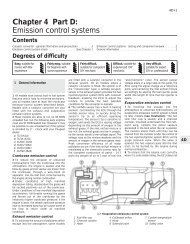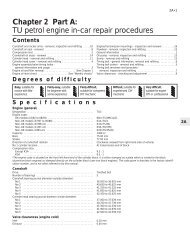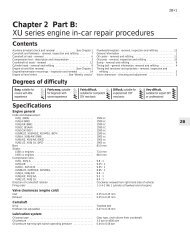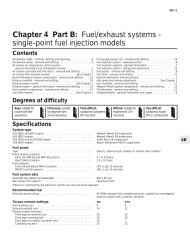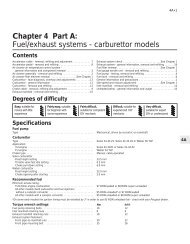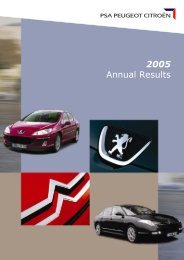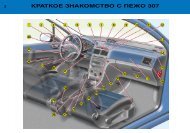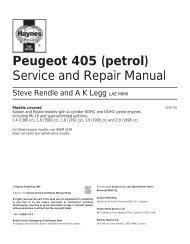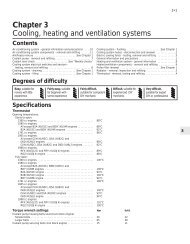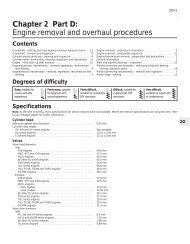Chapter 1 Routine maintenance and servicing
Chapter 1 Routine maintenance and servicing
Chapter 1 Routine maintenance and servicing
You also want an ePaper? Increase the reach of your titles
YUMPU automatically turns print PDFs into web optimized ePapers that Google loves.
6000 Mile / 6 Month Service 1•11<br />
37 Remove the bolts <strong>and</strong> lift off the pump.<br />
Refitting <strong>and</strong> tensioning<br />
38 Refit in reverse order, then tension the<br />
belt by applying a torque of 55 Nm for a new<br />
belt <strong>and</strong> 30 Nm for a used belt by using the<br />
square of a torque wrench in the square cutout<br />
in the pump bracket, tightening the<br />
mounting bolts while the torque tension is<br />
maintained (see illustration).<br />
39 Fill <strong>and</strong> bleed the system (see <strong>Chapter</strong> 10).<br />
5.38 Square cut-out in power steering<br />
pump bracket (a) on XU9J4 16-valve models<br />
Allen key through the special hole <strong>and</strong><br />
tightening the peg.<br />
27 Unscrew the mounting bolts <strong>and</strong> remove<br />
the tensioner roller, then slip the auxiliary<br />
drivebelt from the pulleys.<br />
28 Check that the tensioner pulleys turn<br />
freely without any sign of roughness.<br />
Refitting <strong>and</strong> tensioning<br />
29 If the belt is being renewed, ensure that<br />
the correct type is used. Fit the belt around<br />
the pulleys making sure that it is engaged with<br />
the correct grooves in the pulleys.<br />
30 Refit the tensioner roller <strong>and</strong> tighten the<br />
mounting bolts.<br />
31 Using the square drive key hold the<br />
automatic adjuster, then release the peg <strong>and</strong><br />
slowly allow the tensioner to tighten the belt.<br />
Check again that the belt is correctly located<br />
in the pulley grooves.<br />
32 Reconnect the battery negative lead.<br />
33 Refit the engine undercover <strong>and</strong><br />
wheelarch cover. Refit the roadwheel, <strong>and</strong><br />
lower the vehicle to the ground.<br />
Power steering pump drivebelt<br />
(XU9J4 16-valve) models<br />
Removal<br />
34 Drain the hydraulic fluid from the system<br />
as described in <strong>Chapter</strong> 10.<br />
35 Loosen the pump mounting bolts <strong>and</strong><br />
remove the drivebelt.<br />
36 Disconnect the high <strong>and</strong> low pressure<br />
unions on the pump.<br />
6 Hose <strong>and</strong> fluid leak check<br />
1<br />
Note: On models from 1994, the maker’s<br />
specified interval for this procedure is<br />
9000 miles (15 000 km) or 12 months.<br />
1 Visually inspect the engine joint faces,<br />
gaskets <strong>and</strong> seals for any signs of water, oil or<br />
fuel leaks. Pay particular attention to the areas<br />
around the camshaft cover, cylinder head, oil<br />
filter <strong>and</strong> sump joint faces. Bear in mind that,<br />
over a period of time, some slight seepage<br />
from these areas is to be expected. What you<br />
are really looking for is any indication of a<br />
serious leak. Should a leak be found, renew<br />
the offending gasket or oil seal by referring to<br />
the appropriate <strong>Chapter</strong>s in this manual.<br />
2 Also check the security <strong>and</strong> condition of all<br />
the engine-related pipes <strong>and</strong> hoses. Ensure<br />
that all cable-ties or securing clips are in place<br />
<strong>and</strong> in good condition. Clips which are broken<br />
or missing can lead to chafing of the hoses,<br />
pipes, or wiring, which could cause more<br />
serious problems in the future.<br />
3 Carefully check the radiator hoses <strong>and</strong><br />
heater hoses along their entire length. Renew<br />
any hose which is cracked, swollen, or<br />
deteriorated. Cracks will show up better if the<br />
hose is squeezed. Pay close attention to the<br />
hose clips that secure the hoses to the<br />
cooling system components. Hose clips can<br />
pinch <strong>and</strong> puncture hoses, resulting in cooling<br />
system leaks. If the original Peugeot crimpedtype<br />
hose clips are used, it may be a good<br />
idea to replace them with st<strong>and</strong>ard wormdrive<br />
hose clips.<br />
A leak in the cooling system will usually<br />
show up as white or rust coloured<br />
deposits on the area adjoining the leak<br />
4 Inspect the cooling system (hoses, joint<br />
faces, etc.) for leaks (see Haynes Hint).<br />
5 Where any problems of this nature are<br />
found on system components, renew the<br />
component or gasket, referring to <strong>Chapter</strong> 3.<br />
6 Where applicable, inspect the automatic<br />
transmission fluid cooler hoses for leaks or<br />
deterioration.<br />
7 With the vehicle raised, inspect the petrol<br />
tank <strong>and</strong> filler neck for punctures, cracks, <strong>and</strong><br />
other damage. The connection between the<br />
filler neck <strong>and</strong> tank is especially critical.<br />
Sometimes, a rubber filler neck or connecting<br />
hose will leak due to loose retaining clamps or<br />
deteriorated rubber.<br />
8 Carefully check all rubber hoses <strong>and</strong> metal<br />
fuel lines leading away from the petrol tank.<br />
Check for loose connections, deteriorated<br />
hoses, crimped lines, <strong>and</strong> other damage. Pay<br />
particular attention to the vent pipes <strong>and</strong><br />
hoses, which often loop up around the filler<br />
neck, <strong>and</strong> can become blocked or crimped.<br />
Follow the lines to the front of the vehicle,<br />
carefully inspecting them all the way. Renew<br />
damaged sections as necessary.<br />
9 From within the engine compartment,<br />
check the security of all fuel hose attachments<br />
<strong>and</strong> pipe unions, <strong>and</strong> inspect the fuel hoses<br />
<strong>and</strong> vacuum hoses for kinks, chafing <strong>and</strong><br />
deterioration.<br />
10 Where applicable, check the condition of<br />
the power steering fluid hoses <strong>and</strong> pipes.<br />
1<br />
12 000 Mile / 12 Month Service<br />
7 Engine breather hose check<br />
1<br />
Check the condition <strong>and</strong> security of all<br />
engine breather hoses.<br />
Where the engine has covered a high<br />
mileage, remove the hoses <strong>and</strong> clean any<br />
sludge from them.<br />
8 Fuel filter renewal<br />
2<br />
Note:<br />
Warning: Before carrying out<br />
the following operation, refer to<br />
the precautions in “Safety first!”<br />
<strong>and</strong> follow them implicitly.<br />
Petrol is a highly-dangerous <strong>and</strong> volatile<br />
liquid, <strong>and</strong> the precautions necessary<br />
when h<strong>and</strong>ling it cannot be overstressed.<br />
On models from 1994, the maker’s<br />
specified interval for this procedure is 18 000<br />
miles (30 000 km) for carburettor models, <strong>and</strong><br />
36 000 miles (60 000 km) for fuel injection<br />
models.<br />
Carburettor models<br />
1 The fuel filter is connected into the fuel<br />
hose between the pump <strong>and</strong> the carburettor<br />
in the engine compartment (see illustration).<br />
2 To remove the filter, release the retaining<br />
clips <strong>and</strong> disconnect the fuel hoses from the<br />
filter. Where the original Peugeot crimped-



